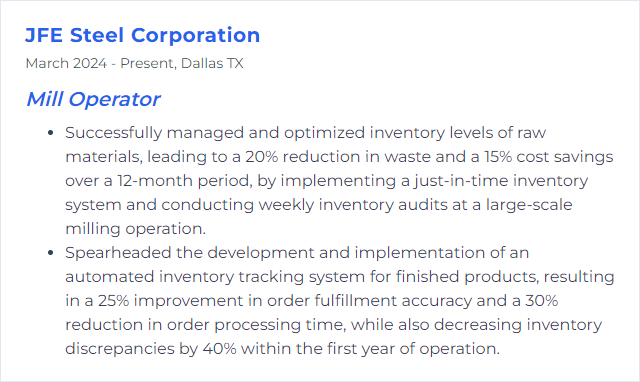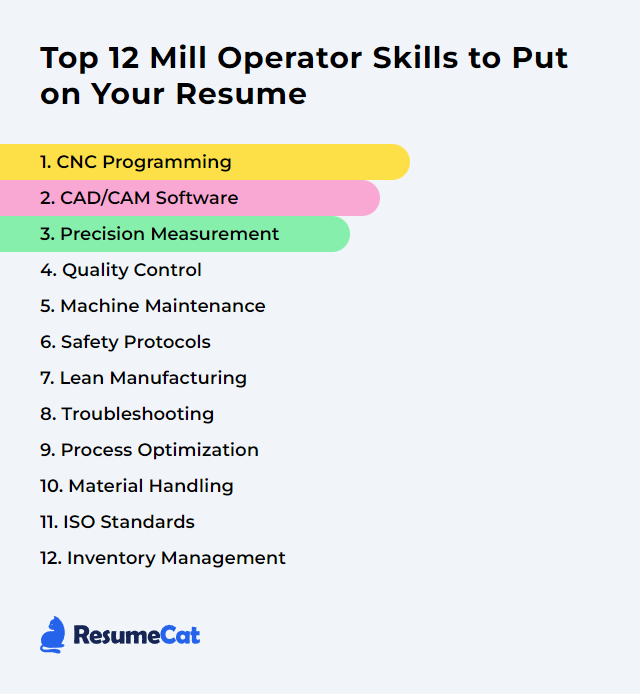Top 12 Mill Operator Skills to Put on Your Resume
In the competitive field of mill operation, having a standout resume is crucial for securing strong positions. Showcasing a sharp, specific skill set signals expertise and readiness to run complex equipment with confidence—making you a compelling hire.
Mill Operator Skills
- CNC Programming
- CAD/CAM Software
- Precision Measurement
- Quality Control
- Machine Maintenance
- Safety Protocols
- Lean Manufacturing
- Troubleshooting
- Process Optimization
- Material Handling
- ISO Standards
- Inventory Management
1. CNC Programming
CNC programming for a mill operator means writing instructions that precisely control machine movement and operations, so the mill cuts and shapes material exactly to spec.
Why It's Important
It drives accuracy, repeatability, and throughput. Better code, better parts. Less scrap. Less downtime.
How to Improve CNC Programming Skills
Boosting CNC programming comes down to speed, consistency, and error-proofing.
Master CAD/CAM workflows: Deepen toolpath strategy knowledge, post-processing, and setup sheet generation. Use training from trusted platforms or vendor academies (e.g., Fusion 360, Mastercam).
Optimize toolpaths: Favor high-efficiency roughing, adaptive clearing, and trochoidal paths where appropriate. Balance tool engagement, chip load, and step-over.
Leverage simulation: Run verification and machine simulation to catch collisions, gouges, and over-travel before chips fly.
Standardize: Create programming templates, naming conventions, and parameter libraries. Align with NIMS-style guidelines for consistency.
Tighten CAM-to-floor feedback: Talk to operators and toolroom staff regularly. Real-world chatter, deflection, and coolant behavior should shape your code.
Stay current: New tooling, coatings, and control features appear fast. Keep learning, test, refine.
Dial these in and your programs become cleaner, faster, safer.
How to Display CNC Programming Skills on Your Resume
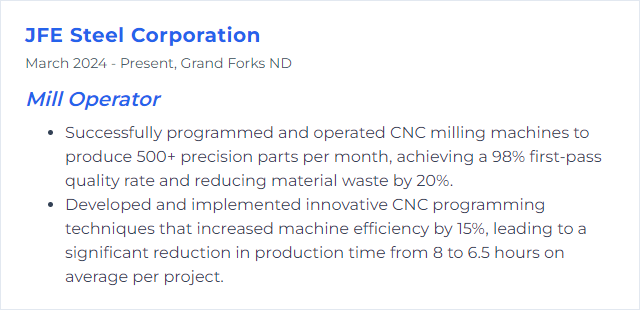
2. CAD/CAM Software
CAD/CAM tools let a mill operator design parts, plan machining strategies, and generate code for CNC machines with precision.
Why It's Important
It compresses lead times, improves accuracy, reduces waste, and enables geometry that would be painful—or impossible—to produce manually.
How to Improve CAD/CAM Software Skills
Focus on the operator’s craft, not just the tool.
Master core features: Sketching, constraints, surfacing, assemblies, and solid modeling. Then dive into CAM: tool libraries, holders, setup, and work offsets.
Toolpath selection: Match strategy to material and geometry. Learn when to use rest machining, multi-axis options, and finishing passes that protect surface finish.
Post and verify: Understand your post processor and control dialects (Fanuc, Siemens, Heidenhain). Simulate with stock models and machine kinematics.
Build libraries: Standardize tools, holders, feeds/speeds, and best-practice templates. Make reuse effortless.
Train deliberately: Short, focused practice projects beat passive watching. Vendor tutorials and community trainings from platforms like Fusion 360, Mastercam, SolidCAM, or GibbsCAM can accelerate learning.
How to Display CAD/CAM Software Skills on Your Resume

3. Precision Measurement
Precision measurement means using accurate instruments and sound technique to verify dimensions against strict tolerances—consistently.
Why It's Important
Good parts ship. Bad parts scrap. Measurement separates the two, protecting quality and cost.
How to Improve Precision Measurement Skills
Calibrate: Keep gages and instruments on a regular calibration schedule consistent with recognized standards (e.g., NIST-traceable).
Use the right tools: Micrometers, bore gages, height gages, gauge blocks, CMMs when needed. Brands like Mitutoyo and Starrett are common in shops.
Control the environment: Temperature, humidity, vibration—stability matters. Monitor and adjust to protect accuracy.
Hone technique: Consistent touch, proper alignment, clean surfaces, correct fixturing. Practice beats guessing.
Maintain equipment: Clean, store, and inspect instruments. Keep machines aligned and backlash in check to reduce stack-up error.
Analyze data: Use SPC to spot drift and variation. Adjust processes before parts drift out of spec.
How to Display Precision Measurement Skills on Your Resume

4. Quality Control
Quality control means monitoring processes and output to ensure products meet defined standards—every time, not just once.
Why It's Important
It protects consistency, reduces waste, and keeps customers (and auditors) satisfied.
How to Improve Quality Control Skills
Standardize work: Clear SOPs, visual work instructions, and checklists aligned with recognized quality standards.
Maintain equipment: Well-maintained machines produce stable results. Prevent surprises with routine checks.
Train for quality: Refresh training on inspection methods, gage R&R, and defect recognition.
Inspect at key points: Incoming, in-process, final. Catch issues early; fix root causes, not just symptoms.
Use technology: In-process probing, automated inspection, SPC dashboards—faster feedback, fewer escapes.
Close the loop: Collect feedback from customers and the floor. Iterate quickly and update controls.
How to Display Quality Control Skills on Your Resume
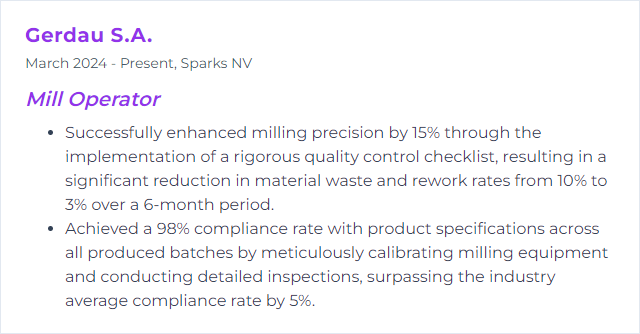
5. Machine Maintenance
Machine maintenance covers inspection, cleaning, lubrication, adjustment, and repair to keep milling equipment humming and extend lifespan.
Why It's Important
Fewer breakdowns, steadier quality, and less unplanned downtime. Reliability is money.
How to Improve Machine Maintenance Skills
Routine inspections: Look for wear, leaks, backlash, spindle noise, and alignment drift. Catch small problems early.
Preventive schedule: Follow manufacturer intervals for lubrication, filter changes, and alignment checks. Log everything.
Right lubrication: Use correct greases and oils, at the right intervals, in the right amounts.
Operator care: Train operators on daily/weekly checks, warm-up cycles, and proper shutdowns.
Records and KPIs: Track MTBF, failure types, and maintenance history. Data guides smarter upkeep.
How to Display Machine Maintenance Skills on Your Resume
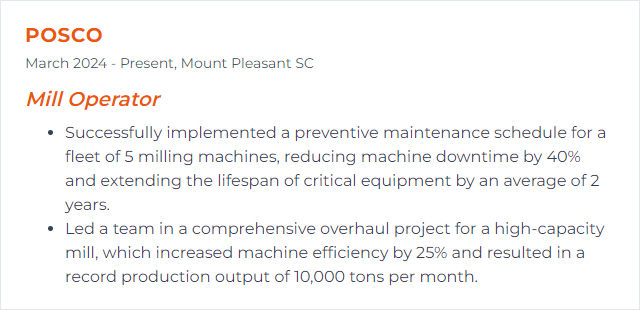
6. Safety Protocols
Safety protocols are the rules, habits, and responses that keep people and machines out of harm’s way—PPE, lockout/tagout, guarding, housekeeping, and solid emergency plans.
Why It's Important
They prevent injuries, protect equipment, and ensure compliance. Most importantly, everyone goes home safe.
How to Improve Safety Protocols Skills
Assess risk: Review hazards for tasks, tools, and materials. Update assessments when processes change.
Train well and often: Equipment operation, hazard recognition, ergonomics, and emergency response. Short refreshers beat long lectures.
Maintain machines: Guarding in place, interlocks functioning, e-stops tested. No shortcuts.
Use proper PPE: Eye, hand, hearing, and respiratory protection matched to the task.
Drill for emergencies: Fire, chemical, power loss, medical events. Practice builds calm.
Speak up culture: Encourage hazard reporting and near-miss sharing—without fear.
Keep improving: Review incidents and audit results. Fix root causes and update procedures.
How to Display Safety Protocols Skills on Your Resume
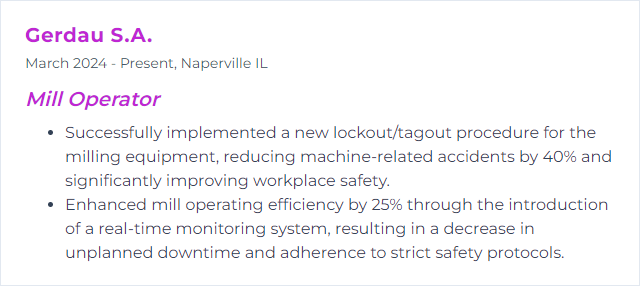
7. Lean Manufacturing
Lean focuses on removing waste and boosting value. For a mill operator, it means smoother flow, cleaner setups, and fewer non-value-added moves.
Why It's Important
Faster lead times, lower costs, better quality. It compounds across shifts.
How to Improve Lean Manufacturing Skills
- Continuous improvement: Use kaizen to chip away at recurring pain points and reduce waste.
- 5S: Sort, set in order, shine, standardize, sustain. A tidy cell runs faster and safer.
- Value stream mapping: See the whole flow, find bottlenecks, then streamline handoffs and queues.
- Preventive maintenance: Stable machines keep takt time steady and quality high.
- Cross-train: Build flexibility to cover absences and balance workloads.
How to Display Lean Manufacturing Skills on Your Resume
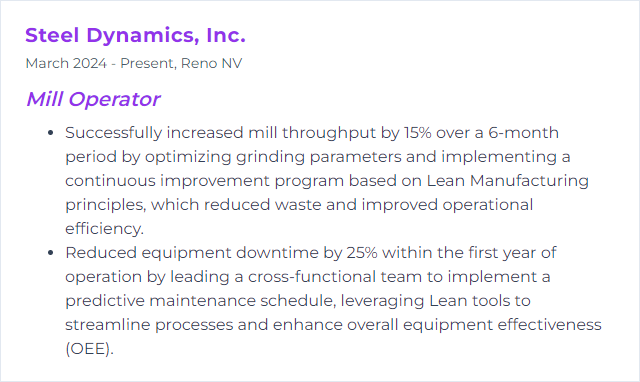
8. Troubleshooting
Troubleshooting means finding faults methodically, fixing them quickly, and preventing repeat failures.
Why It's Important
Downtime is expensive. Fast diagnosis keeps the spindle turning and quality consistent.
How to Improve Troubleshooting Skills
Know the system: Understand controls, drives, pneumatics, hydraulics, and the machining process. Study manuals and ladder logic basics.
Use a structured method: Define the problem, isolate variables, change one thing at a time, verify results, document.
Measure, don’t guess: Indicators, multimeters, thermal cameras, vibration checks—evidence over hunches.
Build playbooks: Common faults deserve checklists: alarm codes, probable causes, quick tests, proven fixes.
Learn from peers: Share cases within your team or professional communities like SME. Collective memory speeds resolution.
Keep current: New controls, new tooling, new coolants—stay aware and keep refining your approach.
How to Display Troubleshooting Skills on Your Resume

9. Process Optimization
Process optimization tightens cycle times, reduces waste, and lifts first-pass yield—deliberately, with data.
Why It's Important
Higher output, lower cost, steadier quality. Competitive edge, day after day.
How to Improve Process Optimization Skills
Instrument and analyze: Use real-time data (e.g., AVEVA PI System-style historians) to monitor OEE, scrap, and cycle time. Let trends guide action.
Automate wisely: Add probing cycles, tool break detection, and lights-out strategies where safe and feasible.
Lean practices: Remove bottlenecks, smooth flow, and shrink queues between operations.
Predictive maintenance: Condition-based alerts reduce unplanned stops and stabilize quality.
Upskill the team: Train on new control features, advanced toolpaths, material behavior, and fixturing strategies.
Energy focus: Optimize spindle speeds, coolant management, and idle states to trim energy costs.
Elevate quality controls: In-process checks, SPC alarms, and error-proofing (poka-yoke) prevent rework.
How to Display Process Optimization Skills on Your Resume
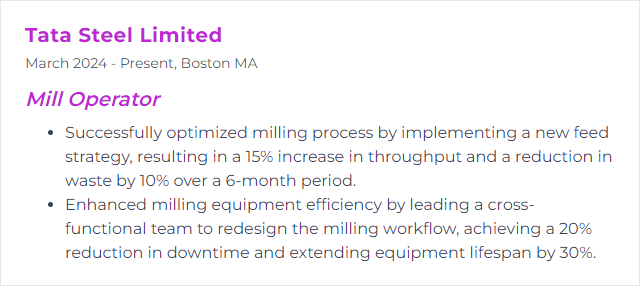
10. Material Handling
Material handling covers moving, storing, protecting, and staging materials—from raw stock to WIP to finished goods—using tools like conveyors, hoists, and forklifts.
Why It's Important
Smoother flow means fewer delays, lower risk, and better throughput. Safety and speed can coexist.
How to Improve Material Handling Skills
Automate smartly: Conveyors, lift assists, and basic robotics reduce manual touches and injuries.
Lean layout: Organize for point-of-use storage and minimal travel distance. Label clearly; color-code wisely.
Train regularly: Forklift certification, rigging basics, safe lifting, and ergonomic techniques.
Ergonomic tooling: Carts at proper height, adjustable workstations, and lift tables reduce strain and errors.
Maintain and upgrade: Keep handling equipment inspected and serviced. Replace worn slings, wheels, and belts before they fail.
How to Display Material Handling Skills on Your Resume
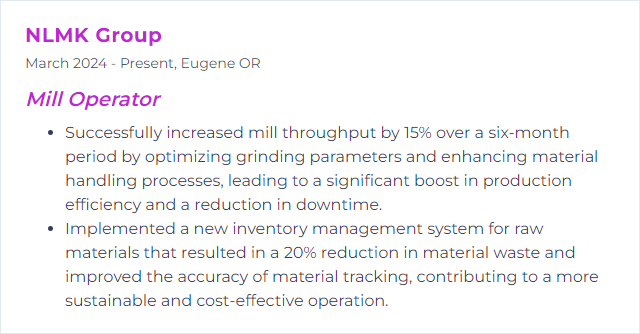
11. ISO Standards
ISO standards are internationally agreed frameworks that guide quality, safety, and efficiency. For mill operations, they anchor processes to consistent, auditable practices.
Why It's Important
They reduce variation, enhance customer trust, and streamline audits. Clarity over chaos.
How to Improve ISO Standards Skills
Know the requirements: Identify applicable standards (commonly ISO 9001 for quality). Map processes to the clauses.
Train and refresh: Educate teams on roles, documentation, and evidence needed to meet requirements.
Optimize processes: Use lean methods to meet standards without bloat. Fewer steps, better control.
QC and QA rigor: Plan audits, conduct layered process audits, and verify corrective actions.
Engage the community: Stay aware of revisions and interpretations through professional groups and standards bodies.
Use PDCA relentlessly: Plan, do, check, act. Continuous improvement is the heartbeat.
Document smartly: Keep procedures, records, and change histories clear and accessible. Make audits painless.
How to Display ISO Standards Skills on Your Resume

12. Inventory Management
Inventory management tracks and controls raw materials, consumables, WIP, and finished goods so production keeps moving without excess stock.
Why It's Important
It keeps lines running, cuts holding costs, and prevents stockouts. Balance is everything.
How to Improve Inventory Management Skills
Digitize tracking: Use a system that updates stock levels in real time with clear locations and lot/serial control.
Forecast demand: Blend historical usage with current orders and lead times. Adjust safety stock intelligently.
Audit routinely: Cycle counts and periodic reconciliations catch errors early.
Strengthen suppliers: Reliable delivery windows, clear specs, and backup sources reduce risk.
Lean inventory: Keep stock minimal but safe. Kanban or min/max controls help avoid whiplash.
Improve continuously: Review discrepancies and root causes; refine processes monthly.
How to Display Inventory Management Skills on Your Resume
